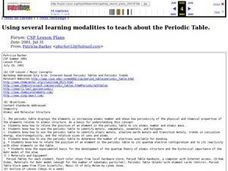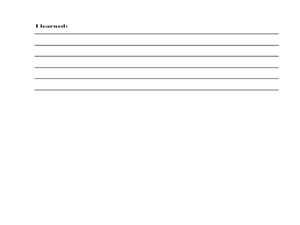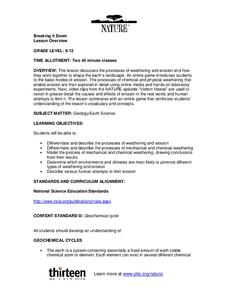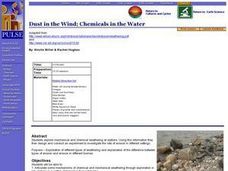Curated OER
Introduction to Bonding
In this chemistry worksheet, students create new and true statements while replacing false ones in order to properly define parts of the concept of bonding.
Curated OER
Moles Worksheet
In this chemistry worksheet, students examine the energy rule of moles and answer the essay questions. The answers are include with the worksheet.
Curated OER
Periodic Table Basics 2
In this periodic table instructional activity, students create cards for a annotated periodic table then use it to answer 16 short answer and fill in the blank questions.
Curated OER
Classifying Matter Game
Students identify the different states of matter. For this chemistry lesson, students differentiate the physical properties of the three states. They apply what they learned by playing a team game at the end of the lesson.
Curated OER
Using several learning modalities to teach about the Periodic Table.
Students identify how to relate the position of an element in the periodic table to its atomic number and atomic mass. They identify how to use the periodic table to identify metals, semimetals, nonmetals, and halogens, and also,...
Curated OER
Code Makers - Electron Configuration, Aufbau Principle
Learners write the electron configuration of elements using the Aufbau principle. In this chemistry lesson, students build their own key that demonstrates the principle.
Curated OER
Periodic Table
Students relate to the idea of periodicity & give example of other periodic events and identify and use the periodic table as a useful resource. They also identify the relationship of elements to certain groups & periods &...
Curated OER
Periodic Table & Its Trends-Day 1
Students are introduced to the periodic table. They find the common trends among the electron configurations and the names of certain groups of the table. Students explore the atomic mass, atomic number, mass number, mass and charge...
Curated OER
Radioactive Decay/Half Life
Young scholars demonstrate radioactive decay using candy corns. For this Physics lesson, students make predictions, collect data and form conclusions about patterns in radioactive decay.
Curated OER
Nuclear Reactions
Starting with a recap of atomic structure, these slides continue by comparing different isotopes of uranium and explaining which are stable and which have a decay period and emit alpha or beta particles. Gamma decay is just mentioned on...
Curated OER
Beat the Greeks
Students conduct research of the history of atomic theory. Information is presented from Democritus and Aristotle to the early Renaissance using the Internet and video.The integration of technology allows for a vast amount of research...
Curated OER
Converting Metric Units and Prefixes
Students investigate the length of various objects. In this measurement lesson, students convert one metric unit to another. They explain the importance of a uniform system of measurement.
Curated OER
Date a Rock!
Young scholars figure the number of half-lives since the sample solidified, and therefore the "age" of the sample rocks.
Curated OER
Molecule Models: Model to Formula and Model to Formula
In this science molecule models worksheet, student convert 8 molecule models to chemical formulas and 8 chemical formulas to molecule models.
Curated OER
Magnetism
In this science worksheet, students apply themselves to the acquisition of new vocabulary while solving the crossword puzzle.
Curated OER
Organic and Biological Compounds
Carbon as a building block for organic compounds is demonstrated by diagrams and facts for its bonding style. Saturated and unstaturated hydrocarbons are detailed and facts about biological compounds such as proteins, nucleic acids,...
Curated OER
Breaking it Down
High schoolers will identify the factors that contribute to erosion and weathering. They will start by differentiating between chemical and mechanical weathering. They then apply what they learned by playing the online jeopardy game. Key...
Chicago Botanic Garden
Carbon, Greenhouse Gases, and Climate
Climate models mathematically represent the interactions of the atmosphere, oceans, land, sun, surface, and ice. Part two in the series of four lessons looks at the role greenhouse gases play in keeping Earth warm and has participants...
Curated OER
Density and Mass
Learners experiment to find which liquids are more dense. In this density and mass activity, students predict and then test objects to observe and measure their density. learners observe which items sink and float. Students complete...
PBS
Breaking it Down
After challenging themselves to correctly choose the form of erosion and length of time required for a given landform to develop, earth science class members model mechanical and chemical weathering with various lab demonstrations over...
Curated OER
Amounts of Dissolved Oxygen in Various Bodies of Water
Students test water to determine the dissolved oxygen content while displaying the proper use of testing instruments while visiting water testing sites. They determine if the amount of dissolved oxygen is appropriate for the tested...
Curated OER
Water Cycle
Ninth graders explore ways water moves through various reservoirs on Earth, examine how human activities change water cycle, investigate substances present in water that indicate human activity, and discuss how understanding water cycle...
Curated OER
Dust in the Wind; Chemicals in the Water
Students explore mechanical and chemical weathering at stations. They articulate some mechanisms of chemical and mechanical weathering through exploration in a lab. Students stations describe how chemical weathering differs from...
Curated OER
The Nature of Salt
High schoolers record information from the periodic table for sodium and chloride. They determine whether salts are molecular or ionic compounds, along with sodium chloride's molecular weight, and relative weights

























